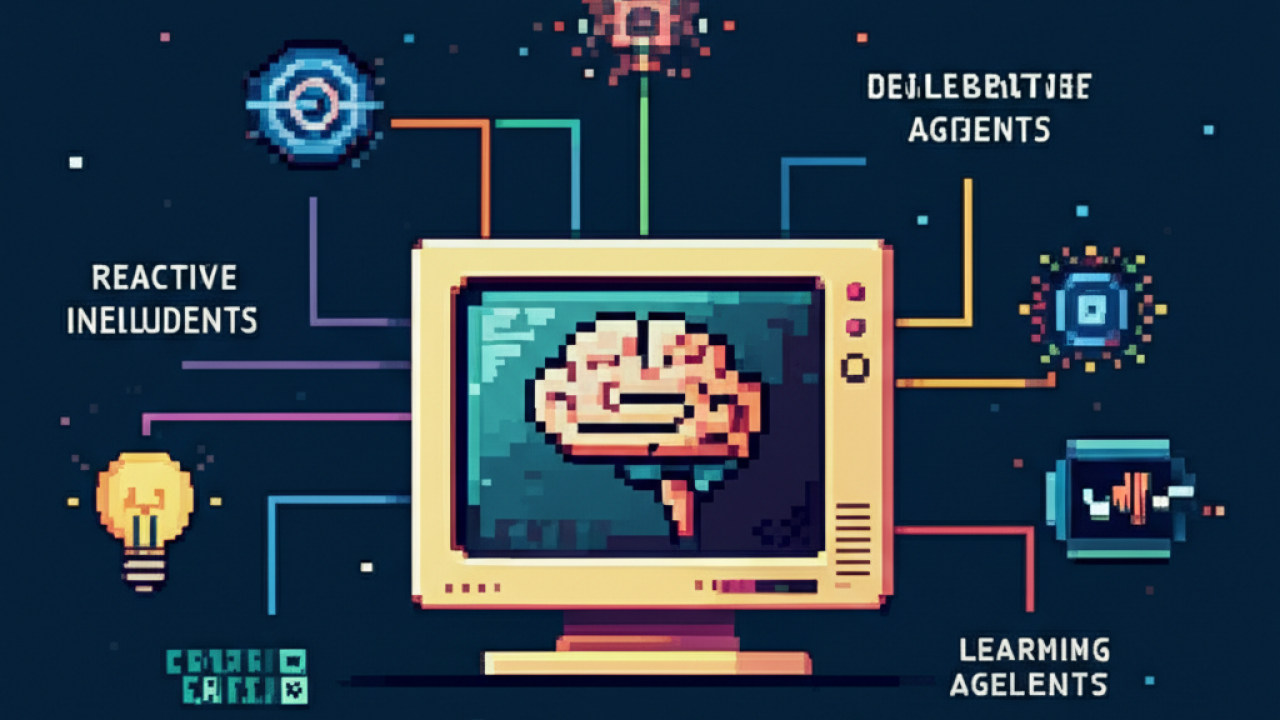Let’s be honest, the term “AI Agent” is everywhere right now. It feels like one of those buzzwords that’s either going to change everything or fizzle out in six months. My bet is on the former. Understanding the different types of AI agents isn’t just academic—it’s about grasping the fundamental shift in how we’re about to build software. We’re moving from writing explicit instructions to designing autonomous systems that perceive, decide, and act on their own.
So, what actually is an intelligent agent? At its core, it’s a system that can:
- Perceive its environment (through sensors, APIs, data streams, etc.).
- Act upon that environment (by making API calls, sending messages, controlling a robot arm, etc.).
- Do this with some degree of autonomy to achieve a specific goal.
This isn’t just a new library or framework. It’s a new architectural paradigm. And if you’re a developer, product person, or just plain curious, you need to understand the different flavors they come in.
The Spectrum of Agent Architectures
Not all agents are created equal. They range from dead simple to terrifyingly complex. Most fall somewhere on a spectrum, and understanding this spectrum is key to knowing when to use which type.
1. Simple Reflex Agents
This is the most basic form of an agent. Think of it as a pure stimulus-response machine. It looks at the current state of the world and executes a rule. That’s it.
How they work: They rely on a set of condition-action rules. “IF this, THEN do that.” There’s no memory of the past and no thought about the future.
Let’s be real: this is just a fancy name for what we’ve been coding for decades.
if (temperature > 72) { turnOnAC(); }
That’s a simple reflex agent. Your smart thermostat is a perfect example. So are many basic customer service chatbots that respond to keywords with pre-written answers.
Limitations: They’re completely stateless. If they get stuck in a loop, they’ll stay there forever because they have no memory of what they just did. They can’t adapt or learn.
Great for simple, predictable environments where the immediate percept is all you need to make a decision.
2. Model-Based Reflex Agents
Here’s where things get more interesting. A model-based agent doesn’t just react to what it sees *right now*. It maintains an internal “model” of the world, which is a representation of how things work.
How they work: They use their perception of the world to update their internal state. This lets them handle situations where they can’t see everything at once. They have a memory of past percepts that helps them understand the current situation.
A Roomba that remembers the layout of your apartment is a great example. It can’t see the whole floor at once, but it builds a map (its model) as it moves. When it bumps into a chair, it doesn’t just react; it updates its internal map with the chair’s location.
Why it’s a big deal: This is the first step towards true “intelligence.” The agent can make better decisions because it has context based on what has happened before.
Use this when the agent needs to understand how the world changes over time and can’t rely solely on the current input.
3. Goal-Based Agents
Now we’re moving from reacting to *planning*. A goal-based agent knows what it wants to achieve. It doesn’t just wander around; it actively considers the future consequences of its actions to find a sequence that leads to its goal.
How they work: They use search and planning algorithms. Think of a GPS navigation system. Its goal is your destination. It doesn’t just pick the next turn randomly; it searches through possible routes (sequences of actions) to find one that gets you there.
These agents ask, “What will happen if I do action A, then B, then C?” to see if that sequence leads to the desired state.
4. Utility-Based Agents
Okay, so reaching the goal is great. But what if there are multiple ways to get there? Some might be faster, some cheaper, some safer. A goal-based agent might see them all as equal. A utility-based agent does not.
How they work: This agent tries to maximize its “utility,” which is just a fancy word for a score that represents happiness or desirability. It has a utility function that evaluates a state and tells the agent how good it is.
Your GPS doesn’t just find *a* route; it finds the *fastest* route. It’s optimizing for time. That’s a utility function. It might also offer a route with no tolls (optimizing for cost) or a more scenic route (optimizing for… scenery).
Why this is so powerful: It allows for decision-making under uncertainty and with competing priorities. A financial trading bot is a classic utility-based agent. Its goal isn’t just “make a profit” but “maximize profit while minimizing risk.” That trade-off is calculated by a utility function.
Utility-based agents are for complex problems where “success” is not a binary state but a spectrum of outcomes. They are the rational decision-makers.
5. Learning Agents: The Game Changer
This isn’t really a standalone type but more of a superpower that can be added to the agents above. A learning agent can improve its performance over time through experience.
How they work: A learning agent has four key components:
- Performance Element: The part of the agent that actually perceives and acts (e.g., the model-based or utility-based component).
- Critic: Provides feedback on how the agent is doing. It compares the outcome to a standard of performance.
- Learning Element: Uses the critic’s feedback to make improvements to the performance element.
- Problem Generator: Suggests new, exploratory actions to take. This is how the agent tries novel things to see if it can find better ways of doing things.
Think about how AlphaGo learned to play Go. It started with a performance element (a utility-based agent), played millions of games against itself (the problem generator), got feedback on whether it won or lost (the critic), and updated its neural networks to make better moves in the future (the learning element).
How Learning Transforms the Other Types of AI Agents
This is where it all comes together. A learning component can make any agent better:
- A model-based agent can learn a more accurate model of the world.
- A goal-based agent can learn more efficient ways to plan.
- A utility-based agent can learn what its user truly prefers, refining its utility function over time. (Think of Spotify’s Discover Weekly playlist).
So, What Does This Mean for Developers?
This isn’t just a taxonomy. It’s a toolbox, one that might soon include the Best AI Code Review Tools of 2025 for streamlining development. For years, we’ve been building systems by telling them exactly *how* to do something. The agent paradigm is about telling them *what* to achieve and giving them the tools to figure out the “how” for themselves.
This is a profound change. Your job shifts from being a micromanager writing line-by-line instructions to being an architect designing goal-oriented systems. This shift also highlights 7 reasons to consider AI code review in your workflow, streamlining development further.
The Hard Parts (Because It’s Never That Easy)
Of course, this introduces new challenges:
- Complexity & Debugging: How do you debug a system that makes its own decisions? When it does something unexpected, is it a bug or an emergent strategy you didn’t anticipate? This is a huge, unsolved problem, and understanding The Biggest Dangers of AI-Generated Code becomes critical here, and a key area where understanding the differences between AI Code Reviews vs. Traditional Code Reviews becomes crucial.
- Defining Success: Crafting a good utility function is more art than science. If you get it slightly wrong, you can get “reward hacking,” where the agent optimizes for the metric but fails at the actual goal (the infamous “paperclip maximizer” problem).
- Tools & Frameworks: The tooling is still nascent. Frameworks like LangChain, AutoGen, and CrewAI are incredible starting points for building LLM-based agents, but we’re still in the early days of figuring out best practices for testing, deploying, and managing them.
Despite the challenges, the direction is clear. We’re on the cusp of building software that feels less like a rigid tool and more like a capable partner.
What to Do Next
If you’re looking to get your hands dirty, here’s a simple path:
- Start Small: Try building a simple reflex or model-based agent. Use an LLM API to classify an incoming email (perceive) and then use a rule to either file it or flag it (act).
- Explore a Framework: Pick up LangChain or CrewAI. Follow their tutorials to build a multi-step agent that can, say, research a topic online, summarize its findings, and write a blog post. This will introduce you to goal-based concepts.
- Think in Agents: The next time you’re designing a feature, ask yourself: “Could an agent do this?” How would you define its environment, its goals, and its possible actions? Just thinking this way will stretch your architectural muscles.
The rise of AI agents is more than just a trend. It’s an evolution in computation, directly addressing What’s the real impact of AI in Software Development, and understanding the core types is the first step toward building the next generation of software.



